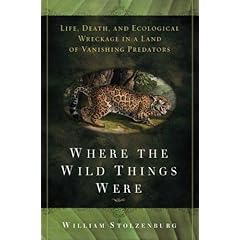Where the Wild Things Were

Life, Death, And Ecological Wreckage In A land Of Vanishing Predators
WILLIAM STOLZENBURG
Ever wonder what the world would be like if most big predator animals had not been eliminated?
Does it frighten you to think of wolves and cougars roaming around wild and free?
Do deer pose a scary problem on roads and in forests in response to a lack of predation?
Do you think of humans as the ultimate top predator?
William Stolzenburg is a science writer, a wildlife journalist that has put together what scientist have found out about the loss of so many keynote predators in ecological communities throughout the world and what happens when they are returned.
It has been fascinating reading.
From Robert T. Paine in 1963, then ecology professor at the University of Washington,recounting his experiment at Mukkaw Bay with removal of predator starfish Pisaster ochraceous, to the return of Wolves at Yellowstone National park,Stolzenburg gives us the many scientist's at work, in the field.
At Mukkaw, Paine over time removed every star fish Pisaster from a ledge of tidal rock while leaving the starfish on adjoining stretches. Where untouched the small communities of marine invertebrates (barnacles,limpets,snails,mussels,chitons and starfish) remained intact and healthy. Where Paine had been prying loose and returning to the sea the predator starfish (main prey a mussel), a monoculture of those predator free mussels remained. The starfish Pisaster was a keynote predator keeping the most aggressive species under control. Without the starfish creating openings of free space where eating the mussels, an invasive crowding out of all other species occurred.
This scene plays out over and over where predator species are eliminated. When killer whales can no longer find enough calories in big sea creatures they practically wipe out whole communities of sea lions and then even small sea otters.
Sea otters eat sea urchins which in turn eat kelp. See where he's going here...
Of particular interest is the story of how deer became such a problem. How wiping out cougars and wolves and even limiting hunting caused tremendous problems not only with deer populations but also deer behaviour.
I cheered when stories of the wolves returned to Yellowstone National Park had such stunning
results. Aspens, cottonwoods and river banks, how could the wolves return revitalize the entire Yellowstone's ecological community? Over ten years later the wolves are thriving and making a difference.
Like The Forgotten Pollinators by Buchmann,Nabhan and Mirocha
and Tracking the Vanishing Frogs: An Ecological Mystery by Kathryn Phillips
'Where The Wild Things Were' by William Stolzenburg
will keep you reading until the last page.
The bibliography alone is worth the price of this book. It is 47 pages of resource heaven.
Click here for the book website
Other reviews...
CS Monitor
Boston Globe
The Green Skeptic blog

